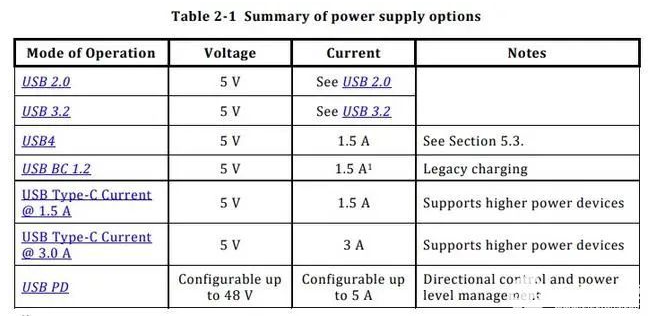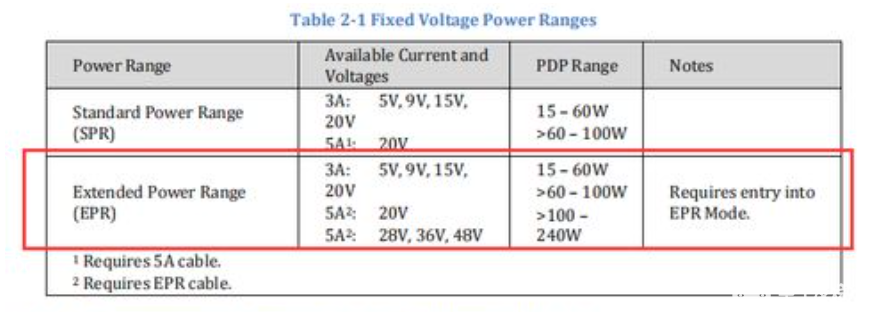June 25, 2021
3277
A major update of the USB PD fast charging standard
Recently, the Universal Serial Bus (USB) standard organization USB-IF announced the revision of the USB PD protocol 3.1 specification to increase the maximum power of USB Type-C from 100W (20V, 5A) to 240W (48V, 5A).
At the same time, the USB Type-C specification has also been updated to version 2.1 to define the requirements for a 240W cable to meet the application requirements of greater charging power. This is a major revision made by the USB standards organization to the mechatronic characteristics of the USB-C interface since the USB Type-C 2.0 specification in August 2019.

In the USB Type-C cable and interface standard v2.1 updated by the USB-IF organization, the charging power can reach up to 240W, and it is named Extended Power Range (Extended Power Range), which is one more than the current maximum of 100W. Much times. However, to support 240W PD, a new USB-C cable is required.

The new USB PD protocol stipulates a more stringent charging protocol, especially for products with a power in the range of 100 ~ 240W (relatively lower power).
New features of USB PD protocol 3.1 specification:

1) Three new fixed voltages are added:
28V voltage, used for more than 100W;
36V voltage for more than 140W
48V voltage for more than 180W
Add the previously defined fixed voltages of 5V, 9V, 15V, and 20V.
2) A new adjustable voltage mode
Depending on the available power, it can range from 15V to one of the three maximum voltages (28V, 36V, or 48V).

2. Wide application range, everything can be charged
The USB PD3.1 standard promotes the power industry to enter the era of "everything can be charged", making the scope of application of the USB PD fast charging standard more and more extensive.
For example, for gaming laptops and monitors, most of the charging voltages are below 20V. When the USB PD3.1 fast charging standard is applied, only a step-down circuit needs to be added to the input of the computer to meet high-power charging above 100W. Requirements.
For power tools, electric bicycles, industrial power supplies and other multi-string lithium-ion battery devices or devices that require high-voltage power supply, due to the high-voltage characteristics of multi-string battery packs, the power range can be expanded directly through USB PD3.1 The voltage is adapted to it.
The USB PD3.1 standard further enhances the versatility of the USB PD fast charging standard. The voltage and power range covers notebook computers, monitors, power tools, industrial power supplies, servers and other products, truly "all things can be charged." At the same time, it will bring a unified situation of USB Type-C interface. The highlight of the USB Type-C interface is a slimmer design, faster transmission speed and stronger power transmission.
Thanks to the USB Type-C interface integrating data, power, video, audio, network and other functions, it has been widely used in smart phones, tablets, laptops, desktop hosts, monitors and other smart hardware devices and chargers. , Mobile hard drives, headsets, U disks, mobile power supplies, data cables, cameras, shavers, and many other accessory products.
The USB PD3.1 standard will further expand the application of the USB Type-C interface in the fields of displays, servers, power tools, security POE power supplies, and DC motors.
3. QC fast charge and PD fast charge
At present, there are two mainstream fast charging, one is QC fast charging led by Qualcomm, and the other is PD fast charging.
QC fast charge
Quick Charge™ (QC) is a fast charging technology developed by Qualcomm. As long as there is an Android phone equipped with its Xiaolong™ Snapdragon system chip, its fast charging technology can be used. In addition to supporting a variety of mobile phones with Xiaolong™ Snapdragon processor, it also supports some processors of other brands.
USB PD fast charge
It is a fast charging specification formulated by the USB-IF organization. This specification can achieve higher voltage and current, and can deliver up to 240W of power, and can freely change the direction of power delivery.
It can be seen from the development history of the USB charging standard that before the release of the USB PD fast charging standard, most devices were charged through the BC1.2 protocol, and the charging power was only 7.5W, and the scope of use was limited to mobile phones, digital cameras and other products. Even if it is used to charge a functional machine with a very small battery capacity, it usually takes 2-3 hours to complete.
Until the release of the USB PD2.0 specification, USB-C was specified as a standard interface, and a maximum fast charging power of 100W was realized. The application range has expanded from traditional feature phones to smart phones, notebook computers, and some displays. But I have to admit that the 100W power that I was proud of 7 years ago has now become a shortcoming that limits the development of USB PD fast charging.
The introduction of the USB PD3.1 standard not only raises the charging voltage standard to 48V, but also increases the output power to 240W, which also increases the scope of application of the USB PD fast charging standard.
4. summary
At present, the maximum output power of USB-C is 100W. In the notebook computer industry, 100W power can only cover most of the thin and light notebooks. Although some high-performance gaming notebooks also support the PD protocol, they can only be used for charging. 100W is far from being able to meet the power consumption of the graphics card + CPU, and after upgrading to 240W, it can basically meet the charging needs of most notebooks. This means that in the future, carrying a charger can meet the charging needs of mobile phones, tablets and notebooks, which can greatly improve portability. Therefore, we predict that the new Type-C standard will accelerate the popularization. However, under the new specifications, users need a new USB charging head and USB Type-C cable to achieve 240W charging power. USB-IF said, "All new EPR cables should have obvious marks on their appearance." To reach the 240W standard, a USB Type-C cable needs to support 5A 50V voltage and current. Therefore, the new standard will also drive the renewal of the supply chain in the entire charging field. We will pay close attention to the development of the new standard, and welcome everyone to follow us for the latest power supply dynamics.